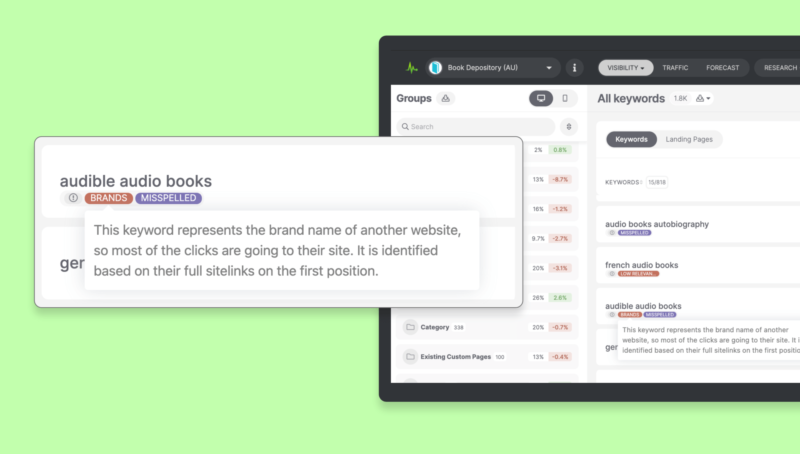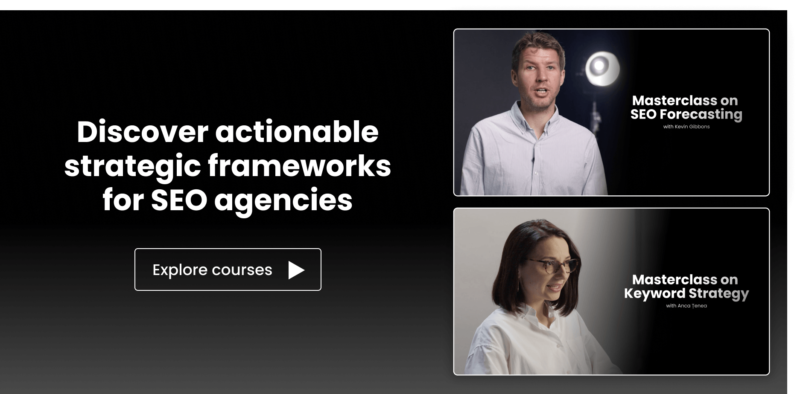
Creating a winning SEO proposal for a new lead is hard work. You need to assess their SEO potential, identify the right strategy for them, and showcase the business value you can create. And then you need to explain it in a way that is meaningful for the client.
A lot of proposals tend to jump directly to how the agency can do that for the lead, yet an important step is missing.
To make your business case compelling, the first thing you need to do is understand what success looks like for your potential client. Then you can speak their language, whether that’s revenue, transactions, conversions, or traffic.
Kevin Gibbons, CEO and founder of Re:signal and SEOmonitor Masterclass educator, points out that what you should do is tie your activity back towards key business outcomes. If you can’t understand and explain exactly what success means and why they need SEO, then there will be no real alignment.
That’s where, Gibbons adds, a reliable forecasting methodology makes the difference. Or as he puts it, a forecast done well will help you define:
- The WHY = What success can look like for the business and its growth potential.
- The HOW = The key areas of the market that the client can grow into.
- The WHAT = The necessary actions your agency can take to achieve those business outcomes.

If the what is pretty straightforward, the why and the how become just as straightforward with the right forecast in place:
Set a realistic business development direction
If you don’t have the bigger picture behind your SEO proposal set, you won’t know where you end up. “The forecast is a great sense check on WHY you are doing this in the first place,” says Gibbons.
This is the step in which creating a forecasting scenario gives you the right overview of the size of the opportunity. You not only get to evaluate if it’s the right lead for your agency but also if SEO is the right choice for the lead’s current business potential.
“You need to give them confidence that the results are realistic. If you’re a new retail brand with very little organic visibility and poor brand awareness/reputation, it’s very unlikely you’re going to be able to start ranking competitively for “sportswear” or ”skirts” overnight,” Gibbons explains.

“Your forecast model should take into account your current opportunity versus the size of the market and break it down into achievable bite sizes so that eventually you can eat that elephant – but you start one achievable bite at a time,” he adds.
SEOmonitor’s forecasting methodology allows you to model the data taking into account all the right inputs that influence your targeted keywords, to create a realistic scenario:
- The CTR value — the average CTR curve for the top 10 positions on each individual combination of SERP features and devices.
- The inertial trend of the non-brand organic traffic, based on search seasonality only (as if the website’s rankings would stand still).
- The Year-over-Year search trend of the keywords included in the Forecast.
- The ranking improvements of long-tail keywords (that are not part of the forecast) and their impact on traffic.

Clarify the client’s growth opportunities
The “why” that fuels your forecast and the SEO proposal is also based on how you curate your initial market and search landscape analysis.
Narrowing down your keyword list and understanding where the SEO opportunities lie will be the solid foundation for your scenarios. If your forecasting input lacks the quality it needs, your estimates will be misleading.
You need to know where you’re heading, the strategic way:
From keyword research to keyword strategy
You can think of the whole framework like this:
- The keyword research is the input that you need to curate, organize and prioritize.
- The keyword strategy is the output — the narrowed-down, categorized keyword groups that inform your action plan and your forecasting foundation.
This framework will help you maximize the impact of your SEO efforts and keep you from wasting resources for both your agency and your client.
But, to do so, you need a correct diagnosis of the client’s status quo and the problem you’re trying to address with SEO.
Map the client’s business
The client’s website categories and buyer personas are crucial for your understanding of the business. You can address their product or service categories as a SWOT (Strengths, Weaknesses, Opportunities, and Threats) analysis and pinpoint the ones that are the most prolific in comparison to their competitors in the search landscape.
There might be the case that the client wants you to focus on certain categories, but you can be proactive in showing them where their strengths lie.
This view combined with the buyer journey will offer you the basis for evaluating demand and search intent — important for setting the right diagnosis. To better grasp the demand, you can think about what search queries the target audience used and reverse engineer the SERPs and the features Google highlights.
Let’s take an example.
Say your client is a small fashion designer with a fairly new website. It won’t make sense to battle big retailers (e.g. GAP and friends) on broad keywords like “dresses” or “jeans” from the get-go. Yet, the designer’s strength lies in customization, so you spot an opportunity for such things as “custom cocktail dresses” or “custom black dress”. Answering the search intent at every step of the journey with content marketing will prove an important part of your diagnosis and action plan: awareness (“little black dress for body shape”), interest (“best black dress”), and consideration (“custom black dress price”).
Map the client’s SEO opportunities
Apart from matching website categories with demand, there are numerous ways of spotting the SEO opportunity.
You can start with the high-opportunity keywords uncovered in your research phase — the keywords with the lowest difficulty to reach the top positions and the highest potential traffic once there.
You can evaluate the desired keywords that have missing landing pages or cannibalization issues and start fixing those immediately.
Then, there’s the problem of timing: spotting seasonal keywords and using them when their peak approaches is another low-hanging fruit, provided you get their timing right. Some, like holiday and actual season-related products and services, are straightforward. It’s the industry-specific ones that will give you the advantage.
Again, for the sake of clarity, let’s take an example.
Your client is an online bookshop preparing for the summer season. Of course, such queries like “best summer holiday reads” or “books to take on the beach” will be addressed. Yet, there might be high-opportunity keywords related to an exclusive event or book with the writer’s autograph, or new editorial launches for the summer months that will be seasonal and industry-specific.
A robust rank tracker can help you work efficiently in prioritizing and segmenting your keywords accordingly, with advanced filtering capabilities to highlight keywords with issues, keywords with low difficulty, high opportunity, and so on. It will save you hours of manually sifting through your initial keyword list.

Set a shared definition of success
Once you’ve uncovered the most relevant keywords out of your research and you found your answers to the diagnostic question, it’s time to test the viability of your SEO proposal.
That’s again where forecasting comes in handy in qualifying both the lead and the size of the opportunity. You can create multiple scenarios with your team and calibrate your keyword strategy until you have a realistic, solid proposal — sharing the final version with your client will further the trust and pave the way for setting expectations.
As we’ve said in the beginning, you should always have a shared definition of what success means for the SEO campaign: additional traffic, additional conversion, revenue, etc. That way, you make sure you track what matters for your client and you both evaluate the SEO performance with the right lens.
The keyword strategy and forecasting exercise are great opportunities to uncover new business potential, as well. This, in turn, positions your agency as a business partner, not just the people executing the SEO tasks.
In conclusion
To prove the ROI of your SEO proposal you need a good understanding of the client’s business and market, the right keyword strategy in place which becomes the basis of a realistic forecasting scenario.
All of these processes ensure that both you and the client speak the same language and know where you want to go in order to achieve business goals and growth targets.
After hundreds of hours of research with our agency clients and many years refining the know-how inside the product, SEOmonitor’s team decided it’s time to distill all that knowledge into a series of masterclasses.
We’ve launched SEOmonitor Masterclass for agency people to further their knowledge with business frameworks applied to their environment and processes. The first two on SEO Forecasting and Keyword Strategy can be freely accessed at masterclass.seomonitor.com.
Both masterclasses include assignments, key takeaways, case studies, and demos for agencies to study and use in their own processes. After completing them, you’ll be able to leverage strategic frameworks for your agency, maximize the impact of your SEO efforts, and make better decisions for your future SEO campaigns.
Join our learning community today and help us bring more transparency to the SEO industry!

The post How to prove SEO ROI and overall business impact appeared first on Search Engine Land.
No comments:
Post a Comment